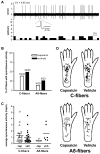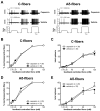Effect of capsaicin treatment on nociceptors in rat glabrous skin one day after plantar incision
- PMID: 19948377
- PMCID: PMC2815239
- DOI: 10.1016/j.pain.2009.10.031
Effect of capsaicin treatment on nociceptors in rat glabrous skin one day after plantar incision
Abstract
Dilute capsaicin produces a differential effect on incision-related pain behaviors depending upon the test; it reduces heat hyperalgesia and guarding pain but not mechanical hyperalgesia. This suggests that common mechanisms for heat hyperalgesia and guarding pain occur, and distinct mechanisms exist for mechanical hyperalgesia. The purpose of the present study was to evaluate the effect of capsaicin treatment on the activity of cutaneous nociceptors sensitized by incision to understand the mechanisms for the selective action of dilute capsaicin on incisional pain. We compared the effect of 0.05% capsaicin vs. vehicle treatment on pain behaviors after incision and on the activity of nociceptors from these same rats using the in vitro glabrous skin-nerve preparation. Immunohistochemical expression of protein gene product 9.5 (PGP9.5), neurofilament 200, calcitonin gene related peptide (CGRP) and isolectin B4 (IB4) in skin was also evaluated 1 week after 0.05% capsaicin infiltration. Infiltration of 0.05% capsaicin decreased CGRP and IB4/PGP9.5-immunoreactivity of nociceptors in skin. The same dose of capsaicin that inhibited heat hyperalgesia and guarding behavior interfered with chemo- and heat sensitivity of C-fibers. Neither mechanical hyperalgesia nor mechanosensitivity of nociceptors was affected by capsaicin, suggesting that the concentration of capsaicin used in this study did not cause fiber degeneration. These results demonstrate that nociceptors desensitized by capsaicin contribute to heat hyperalgesia and guarding pain after plantar incision. These putative TRPV1-expressing C-fibers are sensitized to heat and acid after incision, and the transduction of heat and chemical stimuli after plantar incision is impaired by dilute capsaicin.
Copyright 2009 International Association for the Study of Pain. Published by Elsevier B.V. All rights reserved.
Figures








Similar articles
-
Increased nerve growth factor after rat plantar incision contributes to guarding behavior and heat hyperalgesia.Pain. 2005 Sep;117(1-2):68-76. doi: 10.1016/j.pain.2005.05.017. Pain. 2005. PMID: 16061324
-
Sensitized peripheral nociception in experimental diabetes of the rat.Pain. 2010 Nov;151(2):496-505. doi: 10.1016/j.pain.2010.08.010. Epub 2010 Sep 15. Pain. 2010. PMID: 20832942
-
Guarding pain and spontaneous activity of nociceptors after skin versus skin plus deep tissue incision.Anesthesiology. 2010 Jan;112(1):153-64. doi: 10.1097/ALN.0b013e3181c2952e. Anesthesiology. 2010. PMID: 19996955 Free PMC article.
-
Differential effects of TRPV channel block on polymodal activation of rat cutaneous nociceptors in vitro.Exp Brain Res. 2009 Jun;196(1):31-44. doi: 10.1007/s00221-009-1808-3. Epub 2009 Apr 30. Exp Brain Res. 2009. PMID: 19404626 Review.
-
Peripheral and central mechanisms of cutaneous hyperalgesia.Prog Neurobiol. 1992;38(4):397-421. doi: 10.1016/0301-0082(92)90027-c. Prog Neurobiol. 1992. PMID: 1574584 Review.
Cited by
-
Transient receptor potential vanilloid subtype 1 depletion mediates mechanical allodynia through cellular signal alterations in small-fiber neuropathy.Pain Rep. 2021 Apr 2;6(1):e922. doi: 10.1097/PR9.0000000000000922. eCollection 2021. Pain Rep. 2021. PMID: 34585035 Free PMC article. Review.
-
TRPV1 antagonist attenuates postoperative hypersensitivity by central and peripheral mechanisms.Mol Pain. 2014 Nov 17;10:67. doi: 10.1186/1744-8069-10-67. Mol Pain. 2014. PMID: 25403542 Free PMC article.
-
Hydrogen Peroxide Induces Muscle Nociception via Transient Receptor Potential Ankyrin 1 Receptors.Anesthesiology. 2017 Oct;127(4):695-708. doi: 10.1097/ALN.0000000000001756. Anesthesiology. 2017. PMID: 28640016 Free PMC article.
-
Design and in vitro evaluation of capsaicin transdermal controlled release cubic phase gels.AAPS PharmSciTech. 2010 Sep;11(3):1405-10. doi: 10.1208/s12249-010-9481-1. Epub 2010 Sep 14. AAPS PharmSciTech. 2010. PMID: 20839080 Free PMC article.
-
The pathophysiology of acute pain: animal models.Curr Opin Anaesthesiol. 2011 Oct;24(5):508-14. doi: 10.1097/ACO.0b013e32834a50d8. Curr Opin Anaesthesiol. 2011. PMID: 21841478 Free PMC article. Review.
References
-
- Aasvang EK, Hansen JB, Malmstrom J, Asmussen T, Gennevois D, Struys MM, Kehlet H. The effect of wound instillation of a novel purified capsaicin formulation on postherniotomy pain: a double-blind, randomized, placebo-controlled study. Anesth Analg. 2008;107:282–91. - PubMed
-
- Apfelbaum JL, Chen C, Mehta SS, Gan TJ. Postoperative pain experience: results from a national survey suggest postoperative pain continues to be undermanaged. Anesth Analg. 2003;97:534–40. table of contents. - PubMed
-
- Avelino A, Cruz F. Peptide immunoreactivity and ultrastructure of rat urinary bladder nerve fibers after topical desensitization by capsaicin or resiniferatoxin. Auton Neurosci. 2000;86:37–46. - PubMed
-
- Banik RK, Brennan TJ. Spontaneous discharge and increased heat sensitivity of rat C-fiber nociceptors are present in vitro after plantar incision. Pain. 2004;112:204–13. - PubMed
Publication types
MeSH terms
Substances
Grants and funding
LinkOut - more resources
Full Text Sources
Research Materials

